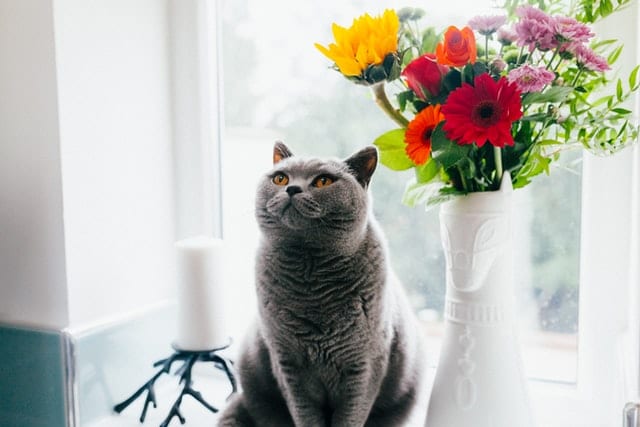- Not a substitute for professional veterinary help.
Lilies go hand-in-hand with spring. We love them for their timeless elegance and fragrant aroma. But are lilies poisonous to cats?
While we can’t deny their aesthetic appeal, lilies are one of the most toxic household plants for cats. In fact, just a few curious nibbles of any part of the plant—leaves, stems, petals, or pollen—is enough to warrant an emergency vet visit. Even the water from a lily’s vase is highly toxic to cats!
Sadly, if left untreated, lily consumption can be fatal in cats. As such, it’s critical to learn the signs of lily poisoning in cats and what to do if your curious kitty ventures a sample of this dangerous plant. Better still—avoid bringing this plant into your home altogether. We’ve got some suggestions for safer floral alternatives to keep your cat safe.
Are Lilies Poisonous to Cats?
Technically, yes: all types of lilies are toxic to cats. That said, some lilies are more dangerous to cats than others.
Lilies from the “true lily” or “daylily” families pose the greatest threat to our feline friends. For your cat’s safety, it’s best to keep these flowers out of your home and garden. According to the FDA, the lilies that are most toxic to cats include:
- Daylily
- Easter lily
- Asiatic lily
- Stargazer lily
- Japanese show lily
- Oriental lily
- Rubrum lily
- Tiger lily
- Wood lily
Some flowers may share the name “lily” but don’t actually belong to the lily family, such as lilies of the valley and gloriosa lilies, however both are still highly toxic to cats. Lilies of the valley contain toxins called cardiac glycosides that cause life-threatening heartbeat irregularities, while gloriosa lilies can cause liver damage or kidney failure.
While not entirely safe, some types of lilies are less harmful to cats, including the calla lily and the peace lily. These flowers contain sharp calcium oxalate crystals that don’t dissolve in water. When chewed or swallowed, the crystals cause oral discomfort, irritating the mouth, tongue, and throat. Symptoms appear immediately after consumption and usually go away on their own.
Keep in mind that every single part of a true lily is toxic to your cat, and she can be poisoned by the plant’s stem, leaves, petals, pollen, or even vase water. It’s also important to understand that no amount of lily consumption is safe for your cat. She doesn’t need to chow down on the whole plant to have an adverse reaction—all it takes is a few curious licks of pollen or a couple of sips of contaminated vase water to cause fatal kidney failure.
Have a dog, instead? Thankfully, lilies aren’t as toxic to our canine pals, and they won’t lead to death in dogs. Nevertheless, lilies can still cause gastrointestinal issues in dogs, so it’s better to keep all of your four-legged friends from eating them.
What Are the Signs of Lily Poisoning In Cats?
Lily poisoning in cats happens fast. According to the Pet Poison Helpline, symptoms can develop as soon as 6-12 hours after consumption. If you suspect your cat has gotten into a lily plant, the importance of getting your cat to the vet quickly can not be overemphasized—do it immediately. Your cat may be exhibiting symptoms of lily poisoning such as:
- Vomiting
- Diarrhea
- Lack of energy
- Loss of appetite
- Drooling
As the condition worsens, you might also see:
- Disorientation
- Tremors
- Seizures
Left untreated, lily poisoning can lead to severe dehydration, kidney failure, and ultimately, death. All within the span of four to seven days.
If you suspect your cat has consumed a calla lily or peace lily, watch for pawing at the face, lip swelling, drooling, vomiting, diarrhea, and vocalization. In some cases, breathing difficulties can occur as a result of the irritation, but this is rare.
What to Do if Your Cat Has Ingested a Lily
-
Photo by Earl Wilcox via Unsplash
While lily toxicity is not something to mess around with, it’s not an automatic death sentence for cats—as long as you seek immediate veterinary assistance.
Timing is everything here. If you have reason to believe that your cat has eaten any amount of a lily plant, contact your vet ASAP. The sooner you seek help, the better your cat’s prognosis will be. If the incident occurs late at night or on the weekend, contact the nearest emergency vet clinic.
If possible, let your vet know the type and amount of lily your cat has consumed. Or better yet—bring a sample of the plant into the clinic to help your vet determine the level of toxicity. A quick snapshot on your phone will also work in a pinch.
If you bring in your cat during the early stages, your vet may perform a process of “decontamination” that involves administering activated charcoal to move the toxins along her digestive tract. Your vet may induce vomiting as well. During treatment, your vet will monitor your cat’s kidney function with tests, while administering IV fluids. If your cat is treated within 24 hours, renal failure can be avoided.
What Should I Do if I Have Lilies in My Home or Garden?
Of course, some of us may already have lilies in our homes or gardens. How can you ensure your cat doesn’t get into them?
For indoor bouquets of lilies, the safest solution is to re-gift them. Surely, your cat-less mother-in-law would appreciate the gesture. If, however, you’re not keen on the idea of giving up your precious lilies, make certain the flowers are inaccessible to your cat. Place them on a high shelf or in a room your cat can’t get into.
If you have lilies in your garden and you allow your cat to go outside, you’ll have to give the flowers the heave-ho. In their place, plant some cat-friendly flowers that won’t put your feline friend at risk.
Cat-Friendly Alternatives to Lilies
-
Photo by Josh Couch via Unsplash
If you like the look of lilies in your home, there are safer alternatives to choose from. These flowers pass the kitty test (and they’re lovely and fragrant, to boot!) Some of our favorite cat-friendly plants include:
- Gerbera Daisy
- Orchid
- Rose (except Christmas or Primroses)
- Snapdragon
- Sunflower
- Zinnia
- Bromeliads
- Lipstick plant
- Burros tail
Ultimately, it’s our responsibility as cat owners to keep our furry pals out of harm’s way. To that end, we need to create a safe environment free of dangerous plants and other toxins. The best way to avoid lily poisoning in cats is pretty obvious: don’t bring those plants into your home! To learn more about plant toxicity and cats, check out our comprehensive database of poisonous plants to dogs and cats.




